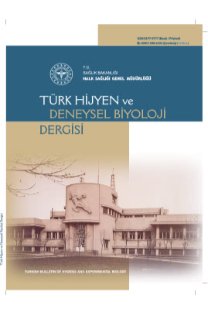Türkiye'nin su ayak izi değerlendirmesi
su ayak izi, üretimin su ayak izi, tüketimin su ayak izi, ayak izi
An evaluation of Turkey's water footprint
water footprint, water footprint of production, water footprint of consumption, footprint,
___
- 1. Hoekstra AY, Mekonnen MM. The water footprint of humanity, 2012; 109,3232–3237.
- 2. Vörösmarty CJ, Green P, Salisbury J, Lammers RB. Global water resources: Vulnerability from climate change and population growth. 2000; 289, 284–288.
- 3. Hoff H. Global water resources and their management. Curr Opin Environt Sustainability 2009; 1, 141–147.
- 4. Manzardo A, Mazzi A, Loss A, Butler M, Williamson A, Scipioni A. Lessons learned from the application of different water footprint approaches to compare different food packaging alternatives, Journal of Cleaner Production. 2016; 112, 4657- 4666.
- 5. Hoekstra AY, Mekonnen MM. Global water scarcity: monthly blue water footprint compared to blue water availability for the world’s major river basins. In: Value of Water Research Report Series, UNESCO-IHE. 2011.
- 6. Jefferies D, Munoz I, Hodges J, King VJ, Aldaya M, Ercin AE et al. Water footprint and life cycle assessment as approaches to assess potential impacts of products on water consumption. Key learning points from pilot studies on tea and margarine. J. Clean. Prod. 2012; 33, 155-166.
- 7. Manzardo A, Ren J, Piantella A, Mazzi A, Fedele A, Scipioni A. Integration of water footprint accounting and costs for optimal chemical pulp supply mix in paper industry. J. Clean. Prod. 2014; 72, 167-173.
- 8. Hess TM, Lennard AT, Daccache A. Comparing local and global water scarcity information in determining the water scarcity footprint of potato cultivation in Great Britain. J. Clean. Prod. 2015; 87, 666-674.
- 9. Morillo JG, Díaz JAR, Emilio Camacho E, Pilar Montesinos P. Linking water footprint accounting with irrigation management in high value crops. J. Clean. Prod. 2015; 87,594-602.
- 10. Türkiye’nin Su Ayak İzi Raporu- Su, Üretim ve Uluslararası Ticaret İlişkisi, WWF-Türkiye, 2014.
- 11. Türkyılmaz A. Dünyada ve ülkemizde su, Su yönetimi ve mevzuatı, Türkiye Belediyeler Birliği, 2010.
- 12. Hoekstra AY., (ed.). Virtual water trade: proceedings of the international expert meeting on virtual water trade , Value of water research report series, No.12, UNESCO-IHE, 2003.
- 13. Kalemci F. Sanal su ve su ayak izi faaliyetleri, Orman ve Su İşleri Bakanlığı- Su Yönetimi Genel Müdürlüğü.
- 14. Mekonnen MM, Hoekstra AY. The green, blue and grey water footprint of crops and derived crop products. (UNESCO-IHE, Delft, The Netherlands) Value of Water Research Report Series. No. 47, UNESCO-IHE, 2010.
- 15. Mekonnen MM, Hoekstra AY. The green, blue and grey water footprint of crops and derived crop products. Hydrol Earth Syst Sci. 2011; 15, 1577- 1600.
- 16. Rodriguez CI, Ruiz de Galarreta VA, Kruse EE. Analysis of water footprint of potato production in the pampean region of Argentina. Journal of Cleaner Production.2015;90,91-96.
- 17. Herath I, Green S, Horne D, Singh R, Clothier B. Quantifying and reducing the water footprint of rain-fed potato production Part I: measuring the net use of blue and green water.
- 18. Hoekstra AY, Chap AK, Water footprints of nations: Water use by people as a function of their consumption pattern, 2007.
- 19. Mekonnen MM, Hoekstra AY, National water footprint accounts: the green, blue and grey water footprint of Production And Consumption. No 50, UNESCO-IHE, 2011.
- ISSN: 0377-9777
- Yayın Aralığı: 4
- Başlangıç: 1938
- Yayıncı: Türkiye Halk Sağlığı Kurumu
Sağlık Kuruluşlarının Su Kullanım Etkinliklerinin İller Düzeyinde Belirlenmesi
Gül İMAMOĞLU, Yıldız KÖSE, Emrullah DEMİRCİ
Yasemin DURDURAN, Mehmet UYAR, Yusuf Kenan BOYRAZ, Lütfi Saltuk DEMİR, Özlen TEKİN, Tahir Kemal ŞAHİN
Halk sağlığı için tehdit oluşturan fenolün sulardan düşük maliyetli bir aktif karbon ile giderimi
Behzat BALCI, Fatma Elçin ERKURT, Emine Su TURAN
Tıp Fakültesi Öğrencilerinin Hazır Su Kullanma Durumlarının Değerlendirilmesi
Dilek ENER, Sinem SIPÇIK, Kaffar IŞIK, İskender GÜN
Şule ŞENSES ERGÜL, Pınar KAYNAR, Mustafa YILMAZ, Yıldırım CESARETLİ, Mustafa Kemal BAŞARILI, İrfan ŞENCAN
Trabzon ilinde halk çeşmelerinin fiziksel, kimyasal, mikrobiyolojik yönden değerlendirilmesi
Sertaç ÇANKAYA, Murat TOPBAŞ, Asuman YAVUZYILMAZ, Şehbal Yeşilbaş ÜÇÜNCÜ, Serdar KARAKULLUKÇU, C.ceyda KOLAYLI, İrem DİLAVER, Gufran ACAR, Büşra PARLAK, Kübra ŞAHİN, Köksal HAMZAOĞLU, Cihan BÖLÜKBAŞ, Gamze ÇAN, N.ercüment BEYHUN
Türkiye'nin su ayak izi değerlendirmesi
Sularda Pestisitlerin LC-MS/MS ile Belirlenmesi
Zehra BALOĞLU, Edibe N. BOZKURT, Arzu BİNİCİ
Huzurevi ve evde kalan yaşlılarda su tüketimi ve ilişkili faktörlerin belirlenmesi
Gamze MUZ, Kamuran ÖZDİL, Gülyeter ERDOĞAN, Fatma SEZER
Yunus Emre BULUT, Ümmühan EVCİL, Süleyman ADIKTI, Mehmet KÖKEL
